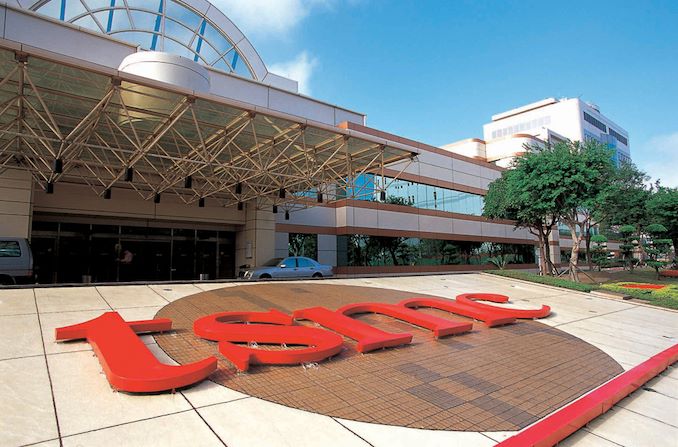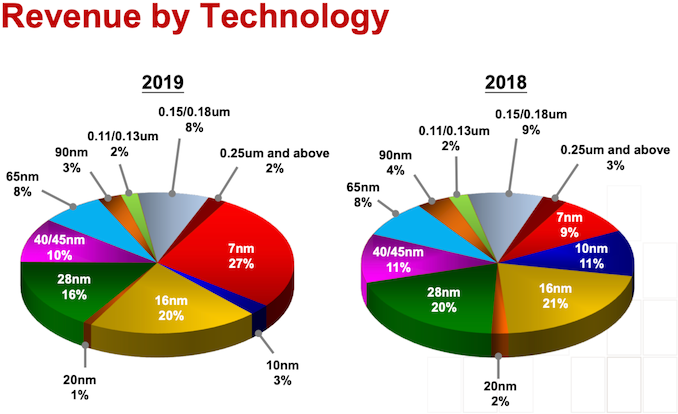TSMC Boosts CapEx by $1 Billion, Expects N5 Node to Be Major Success
by Anton Shilov on January 22, 2020 11:15 AM EST
TSMC is on track to begin high-volume production of chips using its 5 nm technology in the coming months, the company said in its conference call last week. While so far the number of 5 nm tape-outs is lower when compared to the number of 7 nm tape-outs several months before production start, TSMC expects the process to become a major commercial success. Meanwhile, to ensure that it has no production constraints, the company plans to increase its 2020 CapEx by $1 billion.
It is well known that TSMC’s N5 manufacturing technology provides substantial improvements over the company’s N7 fabrication process (1.8x higher transistor density, +15% frequency or -20% power consumption), so major customers of the company are more than inclined to adopt it. TSMC is on track to start high volume manufacturing (HVM) using the technology in the first half of this year. So far, the number of N5 tape-outs is lower when compared to the number of N7 tape-outs at the same stage of development (i.e., several months before HVM) becase alpha customers have taped out a slightly lower number of N5 designs and other clients are yet to catch up. Meanwhile, TSMC remains optimistic about the technology’s ramp and expects N5 revenue to account for 10% of its 2020 wafer sales revenue, which essentially means that business performance of N5 in its first year will be the same as business performance of N7 in its first year.
There are several reasons why TSMC’s N7 node turned out to be a huge commercial success for the foundry. First up, most of its customers skipped the 10 nm node and were more than motivated to go with 7 nm. Secondly, TSMC did not have a strong competition with its N7 technology: GlobalFoundries pulled out of the 7 nm race, whereas Samsung Foundry hardly processed any significant number of wafers using its 7LPP process. Thirdly, because N7 is a considerably more complex technology than TSMC’s 16 nm or 10 nm nodes, the company charges more money per wafer than before, which drives a greater revenue share for the process.
C. C. Wei, Vice Chairman and CEO of TSMC said the following:
“The 5 nm tape-out is little bit less than 7 nm compared at the same stage of the time. However, the most important thing is that the high-volume tape-out is almost equal. So, we expect that our 5 nm ramp is a very fast and smooth and it will contribute about 10% to this year's revenue."
Since TSMC’s N7 is considered as a long-living node, demand for the process is not expected to drop radically when N5 enters HVM, as there are tens of fabless semiconductor developers waiting to produce their 7 nm designs. Apparently, to satisfy demand for chips made using TSMC’s N7, N7+, N7P, N6, N5, and N5P manufacturing technologies (and offer some additional capacity for specialty processes as well as for advanced packaging), the company will have to further increase its 2020 CapEx by a billion of dollars up from $14 billion - $15 billion estimated last year.
TSMC does not say exactly how the additional $1 billion will be spent, but since in the coming quarters it will be ramping production using four process technologies that that use extreme ultraviolet lithography (EUVL) for select layers (up to 14 layers in case of N5, up from 4 and 5 in case of N7+ and N6) and multipatterning for some others, it is likely that the foundry is going to need some additional leading-edge equipment.
Wendell Huang, VP and CFO of TSMC, said the following:
“Other than the advanced technology, we also mentioned earlier, we also increased the CapEx this year for specialty technology as well as advanced packaging. So those are the areas that we are focusing on.”
Related Reading:
- TSMC: 5nm on Track for Q2 2020 HVM, Will Ramp Faster Than 7nm
- TSMC Radically Boosts CapEx to Expand Production Capacities, To Reach $14B For 2019
- Early TSMC 5nm Test Chip Yields 80%, HVM Coming in H1 2020
- TSMC: N7+ EUV Process Technology in High Volume, 6nm (N6) Coming Soon
Source: TSMC











40 Comments
View All Comments
ksec - Thursday, January 23, 2020 - link
Not exactly happy with the Amount. $1B Capex increase is tiny in comparison. The demand for 7nm is much higher than expected. From Network Equipment, 5G Modem, Nvidia GPU, AMD CPU, etc... and hundreds of other queueing up.But knowing TSMC they are very conservative, so an increase of Capex is at least acknowledgement to supply and demand issues.
del42sa - Thursday, January 23, 2020 - link
Poor GloFo, they were so quick in cancelling 7nm right before ramping risk production having two ASML EUV machine already installed in factory... what a smart move.RSAUser - Sunday, January 26, 2020 - link
They'd have to have still researched and developed a 7nm process node, it was the right call for them to fold. Being at the forefront takes a lot of capital for a risky venture, TSMC managed to get it right at a very good timing, only other with as much capital is Samsung and Intel.Spunjji - Monday, January 27, 2020 - link
It really was a smart move. Chasing losses is a loser's strategy when you don't have the capital to stay in the game.Machinus - Thursday, January 23, 2020 - link
Note that it was not even necessary to mention competition from Intel 7nm because Intel is still rehashing 14nm, and has not released any hedt or server 10nm. So Intel is going to go from two to three nodes behind this year.Gondalf - Thursday, January 23, 2020 - link
If they will fix the reported frequence regression versus 7nm this will become true. If data reported by Anandtech in a recent article is true, 5nm will be one of the slower processes available on the market. Density is good, but without raw clock speed you are lost in action badly.RSAUser - Sunday, January 26, 2020 - link
Mind posting what article? That sounds wrong, I don't remember AT stating lower frequencies for 5nm, even this article states +20% performance at same power which should usually be at least a couple of percent higher frequency (no, not linear).Spunjji - Monday, January 27, 2020 - link
"Density is good, but without raw clock speed you are lost in action badly."Yes, that's why AMD's 5Ghz Piledriver chip totally dominated the market. Those denser, more complex 14nm Intel chips just couldn't keep up with the raw clock speed of AMD's 28nm beast.
(This is sarcasm. Also, Gondalf has previously claimed that Ice Lake beats other chips due to IPC so consistency is not his strong point)
Korguz - Tuesday, January 28, 2020 - link
thats where you are wrong Spunjji... gondalf IS consistent, he is consistent spreading fud, BS, misinformation, etc :-)Foeketijn - Wednesday, January 29, 2020 - link
It would be interesting if somehow TSMC takes GoFlo along. In the form of a takeover or Partnership.